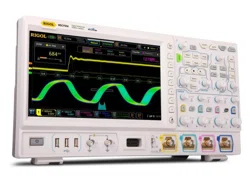Loading ...
Loading ...
Loading ...

Chapter 11 Protocol Decoding RIGOL
MSO7000/DS7000 User's Guide 11-29
clock channel, a dotted line displaying the current threshold level is
displayed on the screen. The dotted line disappears in about 2 s after you
stop modifying the threshold.
4. Signal setting
Press Settings to enter the signal setting menu.
Set the signal type
Press Signal and rotate the multifunction knob to select a signal type
that matches the CAN bus signal. Press down the knob to select it. You can
also press Signal continuously or enable the touch screen to select it. The
available signal types include CAN_H, CAN_L, Rx, Tx, and Diff.
CAN_H: indicates the actual CAN_H bus signal.
CAN_L: indicates the actual CAN_L bus signal.
Rx: indicates the Receive signal from the CAN bus transceiver.
Tx: indicates the Transmit signal from the CAN bus transceiver.
Diff: The CAN differential bus signals connected to an analog source
channel by using a differential probe. Connect the probe's positive lead
to the CAN_H bus signal and connect the negative lead to the CAN_L
bus signal.
Specify the standard signal rate
Three setting methods are available for baud rate:
Press Baud, then set the user-defined baud rate with the displayed
numeric keypad.
Press Baud, then select the preset baud rate from the available
options. The available baud rates include 10 kbps, 20 kbps, 33.3 kbps,
50 kbps, and etc.
Press Baud, then rotate the multifunction knob to adjust the baud
rate at a small step.
Sample Position:
Sample position is a point within a bit’s time. The oscilloscope samples the
bit level at this point. The sample position is represented by the proportion
of "the time from the start of the bit to the sample position" to the "bit time",
as shown in the figure below.
Figure 11-10 Sample Position
One Bit
60%
70%
80%
Loading ...
Loading ...
Loading ...
